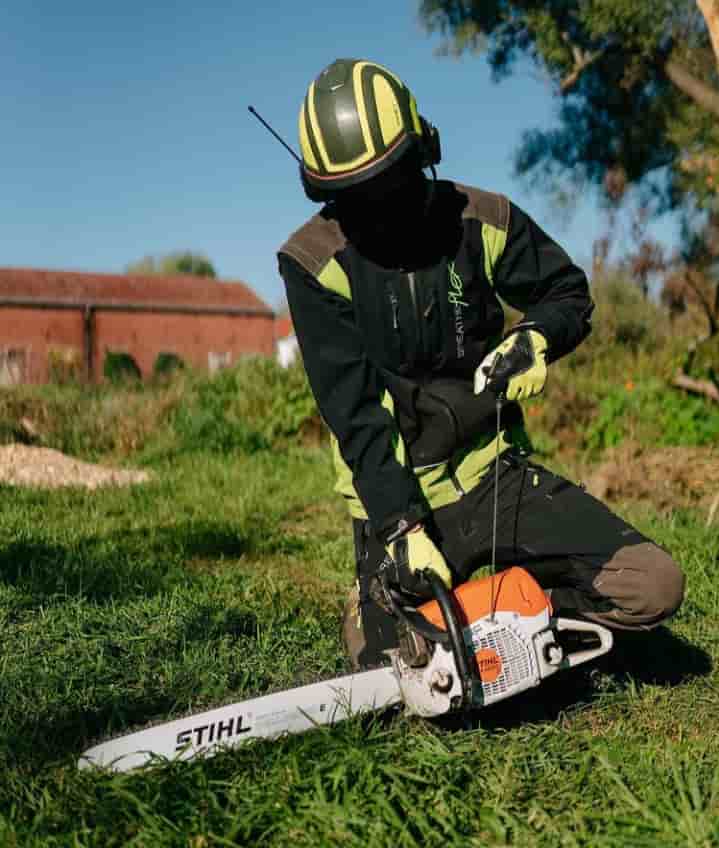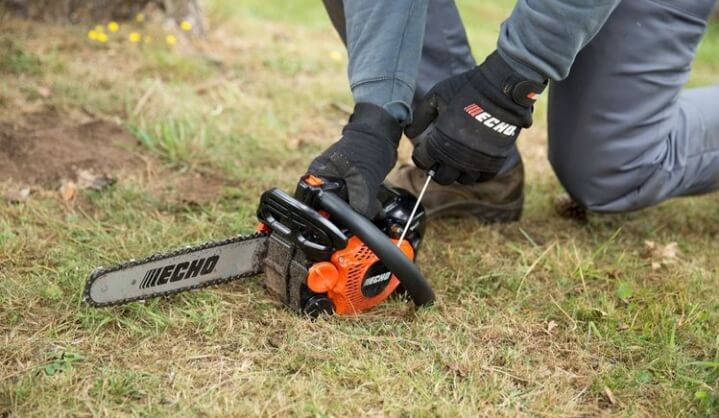It can be frustrating when you are trying to start your chainsaw, but it will not turn on. The situation is even more frustrating when you see the engine is flooded with fuel; this leaves little room for anything else.
You feel like giving up and then realize that there is still hope in starting the machine. This article aims to teach you step by step how to successfully start a flooded chainsaw.
Before we continue with any further information about how to start a flooded chainsaw, let us take some time to discuss what causes this problem in the first place.
A lot of people make the mistake of either over-priming or over-squeezing their fuel bulb while refueling their chainsaws which leads to flooding of the carburetor.
Whatever the cause may be, there are two steps on how to start a flooded chainsaw: remove excess fuel from the combustion chamber and then try again.
Excess fuel is one of the most common reasons why chainsaws will not turn on because once inside your engine, it can destroy many parts including valves that are installed near the spark plugs. If this happens, your best option will be to visit a professional mechanic who will remove the excess fuel so your chainsaw is ready to be used again.
Table of Contents
If you are up to doing it yourself, here are some easy steps on how to start a flooded chainsaw:

Step 1: Place your chainsaw on a flat surface before doing anything. This will make it easier for you to work on your machine because it does not need any support at this time.
Step 2: Remove all covers that are made of plastic or wood to expose the engine. Note that there are different models available in the market; therefore, remove only what is needed to access your carburetor.
Most of them should have one or two screws that hold it in place while others may require you to unscrew some nuts and bolt as well as cut wires (not really). Once complete, remove the plastic or wood covers carefully so you do not damage them.
Step 3: The next thing to do is to disconnect your saw’s high voltage power cap that is attached to the spark plug. This part is usually made of rubber and has a built-in fuel filter. It can be found somewhere near the tip of your machine’s spark plug (most likely it is wet with fuel).
You can easily take it off by hand; however, make sure you are only touching the insulation part and not where it gets attached at. Once removed, place it aside for now as we will be using this later on in our process (you may choose to throw it away if you like because it does not offer anything but a mess).
Step 4: Now, it is time to remove the spark plug itself. For this, you will need a wrench that is usually supplied with your chainsaw when you buy it. If you do not have one, then you can use any other wrench that fits the size of your machine’s spark plug.
It is important to note that before unscrewing the spark plug, you should first wipe off any excess fuel from its electrode (the metal part where electricity comes out). Doing so would help in creating a good connection when you try to start your chainsaw.
Step 5: With the spark plug now loose, take a look at it and see that the electrode is wet with fuel. This means that has occurred and more than likely, there is fuel in the combustion chamber.
If this is the case, there are two things you can do: try to start it or wait until the fuel evaporates. Waiting might be the better option especially if you do not have any experience in trying to start a chainsaw that has been flooded.
Step 6: Now that the spark plug is removed, use a paper napkin to plug up the hole on the cylinder where it screws in (make sure it covers the entire hole). This will help prevent any more fuel from entering the combustion chamber.
Step 7: Place your chainsaw back on a flat surface and get ready to start it. Make sure your hands are dry before doing anything and that there is no debris or objects near the saw’s muffler area.
Step 8: To start the chainsaw, first make sure it is in its lowest setting possible (this will help prevent any damage that might occur when you pull on the starter cord). Next, hold down your saw’s throttle trigger to get it going. Keep holding until you are ready to try out the next step.
You might like our article on Best Chainsaw For Wood Carving
Now take your high voltage cap and put it back in the place where you removed it from. This part is very important, do not lose this. It can explode or catch fire if not properly installed or maintained after each use of your saw. Finally, pull the starter cord to spark up your chainsaw and give it a go.

What are some basic troubleshooting techniques for default chainsaws?
Start by checking the air filter to make sure it is not clogged, then check the chain lubrication and tighten any loose screws. If the saw still does not start, try spraying a small amount of starting fluid directly into the carburetor while pulling the starter cord. If that still doesn’t work, then the engine may need to be rebuilt or replaced. Finally, if all else fails, take the chainsaw to a professional technician for repair.
What are some common causes of chainsaw flooding?
A chainsaw can flood if there is too much fuel in the combustion chamber, if the spark plug is not properly installed or if there is an issue with the carburetor. Other causes can include a dirty air filter or a loose chain.
How do I start a flooded chainsaw?
There are a few things you can do to try and start a flooded chainsaw. First, check the air filter and make sure it’s clean. If it’s not, clean it off and try starting the chainsaw again. You can also try pouring some gasoline into the air intake to help get the engine going. If all else fails, you may need to take the chainsaw to a repair shop.
How can I prevent my chainsaw from flooding?
There are several things you can do to help prevent your chainsaw from flooding, including making sure the air filter is clean, tightening any loose screws, and checking the chain lubrication. You can also try spraying a small amount of starting fluid directly into the carburetor while pulling the starter cord. If that still doesn’t work, then the engine may need to be rebuilt or replaced. Finally, if all else fails, take the chainsaw to a professional technician for repair.
What are some common symptoms of a chainsaw that has been flooded?
Some common symptoms of a chainsaw that has been flooded include an inability to start, excessive smoke, and/or sparks coming from the muffler area. You may also smell gasoline or oil while trying to start the saw. Finally, you might hear a clicking sound when pulling the starter cord.
What are some common causes of an engine that has been flooded?
A chainsaw’s engine can be flooded by too much fuel in the combustion chamber, if the spark plug is not properly installed or if there is an issue with the carburetor. Other causes can include a dirty air filter or a loose chain.
What tools are required for starting up my chainsaw?
The only tool necessary for starting up your chainsaw is your high voltage cap, otherwise known as your “spark plug.” Regardless of what type of chainsaw you have, this part needs to be put back into place after you have finished starting up your chainsaw.
Can I use a chainsaw if it’s flooded?
It’s not advisable to use a chainsaw if it’s flooded. The water can damage the engine, and it may be difficult to get them started. If you try to use a chainsaw that’s flooded, you may end up doing more damage to the saw. It’s best to take it to a repair shop and have them take a look at it.
What should I do if my chainsaw won’t start?
If your chainsaw won’t start, there are a few things you can try. First, check the air filter and make sure it’s clean. If it’s not, clean it off and try starting the chainsaw again. You can also try pouring some gasoline into the air intake to help get the engine going. If all else fails, you may need to take the chainsaw to a repair shop.
How often should I sharpen my chainsaw blade?
It’s a good idea to sharpen your chainsaw blade regularly. The frequency will vary depending on how often you use the chainsaw, but it’s generally a good idea to sharpen it every few months. You can either do it yourself or take it to a professional sharpener.
Can I use my chainsaw if the chain is loose?
It’s not advisable to use your chainsaw if the chain is loose. If the chain is too loose, it can come off the bar and cause serious injury. It’s best to take the chainsaw to a repair shop and have them take a look at it. They may be able to tighten the chain for you.
Conclusion
Now that you know how to start a flooded chainsaw, you can go out and cut some wood. Just be sure to follow the safety instructions and precautions outlined earlier, and you should be good to go.
You may see our articles on Best Small Gas Powered Chainsaw and How To Take A Link Out Of A Chainsaw Chain.

